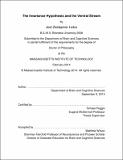The invariance hypothesis and the ventral stream
Author(s)
Leibo, Joel Zaidspiner
DownloadFull printable version (6.616Mb)
Other Contributors
Massachusetts Institute of Technology. Department of Brain and Cognitive Sciences.
Advisor
Tomaso Poggio.
Terms of use
Metadata
Show full item recordAbstract
The invariance hypothesis is the claim that properties of the ventral stream can be deduced from 1. a consideration of the computational problem with which it is engaged: invariant object recognition, 2. constraints of the neural "hardare", and 3. the visual environment. We are interested here in a particular instantiation of this idea. A recent general theory of hierarchical networks for invariant recognition [1] describes many modern convolutional networks as special cases, and also implies the existence of a wider class of algorithms, which we are only now beginning to explore. Our version of the invariance hypothesis is the claim that the algorithm implemented by the ventral stream is also in this class. As applied to the brain, the theory follows from a few simple and commonly accepted premises. This thesis contributes several models/studies in which properties of the ventral stream are deduced and explained in the context of the theory. The main contribution here is providing a general framework through which disparate results concerning many parts of the ventral stream, and even different levels of analysis [2], can be bridged and understood. In that sense, it is primarily a Neuroscience contribution. However, the ideas and algorithms it suggests may also have implications for the broader question of how to learn representations capable of supporting intelligence.
Description
Thesis: Ph. D., Massachusetts Institute of Technology, Department of Brain and Cognitive Sciences, 2014. Cataloged from PDF version of thesis. Includes bibliographical references (pages 122-138).
Date issued
2014Department
Massachusetts Institute of Technology. Department of Brain and Cognitive SciencesPublisher
Massachusetts Institute of Technology
Keywords
Brain and Cognitive Sciences.